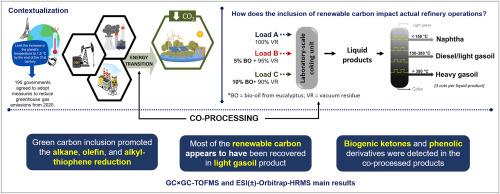在实验室规模的焦化装置中协同处理生物质衍生碳:液体产品及其蒸馏切割的详细化学评价
IF 5.8
2区 生物学
Q1 AGRICULTURAL ENGINEERING
引用次数: 0
摘要
在传统炼油厂中加入生物燃料是一个很有前途的选择,可以增加传统化石燃料和产品的绿色碳含量。然而,生物油(BO)包裹体对常规炼油厂典型步骤的影响还有待进一步研究。本研究旨在对慢热解生物油与真空渣油(VR)共加工的焦化液产品及其蒸馏馏分进行单独的化学结构分析,以评估BO包合物对常规炼油工艺的影响。采用综合二维气相色谱-飞行时间质谱联用和Orbitrap高分辨率质谱联用电喷雾电离正负模式。在实验室规模的焦化装置中,使用三种批次负载获得液体产品:(a) 100% VR, (B) 95% VR和5% BO;(C) 90% VR和10% BO。焦化批中生物质包碳促进了液体产品中烷烃、烯烃和烷基噻吩浓度的降低。液体产品B和C中分别检测到c1 -烷基环戊烯酮(42.7 μg−1)和C1-C3烷基环戊烯酮(392.3 μg−1)。蒸馏后,轻质汽油中生物油的贡献更大。因此,在焦化装置中协同处理生物质衍生碳可以增加绿色碳含量,特别是在石脑油和轻质汽油产品中,并且可以代表公平能源转型的良好选择。本文章由计算机程序翻译,如有差异,请以英文原文为准。

Biomass-derived carbon co-processed in a laboratory-scale coking unit: Detailed chemical evaluation of liquid products and their distillation cuts
The insertion of biofuels into conventional refineries is a promising option that can increase the green carbon content of traditional fossil fuels and products. However, the influence of bio-oil (BO) inclusion in the typical steps of conventional refineries is still understudied. This work aims to perform individual chemical structural elucidation of coking liquid products from slow pyrolysis bio-oils co-processed with vacuum residue (VR), as well as their distilled fractions to evaluate the influence of BO inclusion in a conventional refinery process. Comprehensive two-dimensional gas chromatography coupled with time-of-flight mass spectrometry and Orbitrap high-resolution mass spectrometry with electrospray ionization in positive and negative modes were used. Liquid products were obtained in a laboratory-scale coking unit using three batch loadings: (A) 100 % VR, (B) 95 % VR and 5 % BO; and (C) 90 % VR and 10 % BO. The biomass-derived carbon inclusion in the coking batch promoted the reduction of alkane, olefin, and alkyl-thiophene concentrations in the liquid product. Biogenic C1-alkyl-cyclopentenones (42.7 μg g−1) and C1-C3 alkyl-cyclopentenones (392.3 μg g−1) were detected in liquid product B and C, respectively. After distillation, a greater bio-oil contribution was observed in light gasoils. Thus, biomass-derived carbon co-processed in the coking unit can increase the green carbon content, particularly in naphtha and light gasoil products, and can represent a good option for a fair energy transition.
求助全文
通过发布文献求助,成功后即可免费获取论文全文。
去求助
来源期刊

Biomass & Bioenergy
工程技术-能源与燃料
CiteScore
11.50
自引率
3.30%
发文量
258
审稿时长
60 days
期刊介绍:
Biomass & Bioenergy is an international journal publishing original research papers and short communications, review articles and case studies on biological resources, chemical and biological processes, and biomass products for new renewable sources of energy and materials.
The scope of the journal extends to the environmental, management and economic aspects of biomass and bioenergy.
Key areas covered by the journal:
• Biomass: sources, energy crop production processes, genetic improvements, composition. Please note that research on these biomass subjects must be linked directly to bioenergy generation.
• Biological Residues: residues/rests from agricultural production, forestry and plantations (palm, sugar etc), processing industries, and municipal sources (MSW). Papers on the use of biomass residues through innovative processes/technological novelty and/or consideration of feedstock/system sustainability (or unsustainability) are welcomed. However waste treatment processes and pollution control or mitigation which are only tangentially related to bioenergy are not in the scope of the journal, as they are more suited to publications in the environmental arena. Papers that describe conventional waste streams (ie well described in existing literature) that do not empirically address ''new'' added value from the process are not suitable for submission to the journal.
• Bioenergy Processes: fermentations, thermochemical conversions, liquid and gaseous fuels, and petrochemical substitutes
• Bioenergy Utilization: direct combustion, gasification, electricity production, chemical processes, and by-product remediation
• Biomass and the Environment: carbon cycle, the net energy efficiency of bioenergy systems, assessment of sustainability, and biodiversity issues.
 求助内容:
求助内容: 应助结果提醒方式:
应助结果提醒方式:


